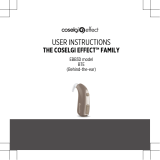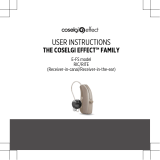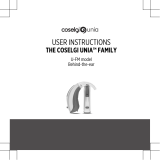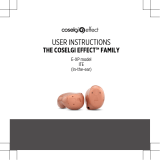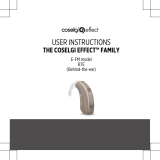Page is loading ...

USER INSTRUCTIONS
THE WIDEX DAILY™ FAMILY
D-m CB model
Behind-the-ear

YOUR WIDEX® HEARING AID
(To be filled out by the hearing care professional)
Your hearing aid series:
PROGRAMS
Master
Music
TV
Comfort
Reverse focus
Phone
Zen
SPECIAL PROGRAMS
Master + Zen
Master + Phone
Master + Reverse focus
2

SMARTTOGGLE PROGRAMS
Zen+
NOTE
Not all hearing aids can be used with a DEX accessory.
NOTE
Some programs not available in all hearing aids.
NOTE
Read this booklet and the booklet "Ear-sets for Widex hearing aids" carefully
before you start using your hearing aid.
3

CONTENTS
YOUR WIDEX HEARING AID.......................................................................6
Welcome to Widex..........................................................................................6
Your hearing aid at a glance.......................................................................6
Important safety information.........................................................................7
THE HEARING AID......................................................................................9
Indications for use........................................................................................... 9
Intended use.....................................................................................................9
The battery.......................................................................................................9
Low battery indication...............................................................................10
Changing the battery.................................................................................10
Tamper-resistant battery drawer..............................................................11
Sound signals..................................................................................................12
Lost partner ................................................................................................ 13
How to tell right from left..............................................................................13
Turning the hearing aid on and off...............................................................13
Putting on and removing your hearing aid.................................................14
Sound adjustment..........................................................................................15
Programs.........................................................................................................15
The Zen program........................................................................................ 17
Changing programs....................................................................................17
4

Using a telephone with hearing aids............................................................17
CLEANING.................................................................................................18
Tools.................................................................................................................18
Cleaning the hearing aid................................................................................18
ACCESSORIES..........................................................................................20
TROUBLESHOOTING.................................................................................21
REGULATORY INFORMATION...................................................................23
EC directives...................................................................................................23
Directive 2014/53/EU................................................................................ 23
Information regarding disposal................................................................23
FCC and IC statements..................................................................................23
SYMBOLS................................................................................................. 27
5

YOUR WIDEX HEARING AID
Welcome to Widex
Congratulations on your new hearing aid.
Use your hearing aid regularly, even if it takes some time getting used to it.
Infrequent users don’t usually get the full benefit of a hearing aid.
NOTE
Your hearing aid and its accessories may not look exactly as illustrated in this
booklet. We also reserve the right to make any changes we consider necessary.
Your hearing aid at a glance
The illustration shows your hearing aid without the ear-set. For further in-
formation on the ear-set, see the ear-set manual. The ear-set consists of an
earwire and an ear-tip, and it is the part of your hearing aid that you wear
inside your ear.
1
2
3
1. Microphone openings
2. Nail grip with on/off function
3. Right/left identification
6

Important safety information
Read these pages carefully before you begin using your hearing aid.
Hearing aids and batteries can be dangerous if swallowed or used im-
properly. Swallowing or improper use can result in severe injury or even
fatalities. In case of ingestion, contact your local emergency number or
hospital immediately.
Take your hearing aids out when you are not using them. This will help to
ventilate the ear canal and prevent ear infections.
Contact your doctor or hearing care professional immediately if you sus-
pect you may have an ear infection or an allergic reaction.
Contact your hearing care professional if the hearing aid doesn't feel
comfortable, or if it doesn't fit properly, causing irritation, redness or the
like.
Remove your hearing aids before showering, swimming or using a hair
dryer.
Do not wear your hearing aids when applying perfume, spray, gels, lotion
or cream.
Do not dry your hearing aid in a microwave oven - this will ruin it.
Never use other people’s hearing aids and never allow others to use
yours, as this could damage your hearing.
Never use your hearing aids in environments where there may be explo-
sive gases, such as in mines, etc.
7

Keep hearing aids, their parts, accessories and batteries away from chil-
dren and mentally disabled people.
Never try to open or repair the hearing aid yourself. Contact your hearing
care professional if you need to have your hearing aid repaired.
Your hearing aids contain radio communication technology. Always ob-
serve the environment in which you are using them. If any restrictions ap-
ply, you must take precautions to comply with these.
Your hearing aid is very powerful and it can play sounds that exceed a
level of 132 dB. There may therefore be a risk of damaging your remain-
ing hearing.
Do not expose your hearing aids to extreme temperatures or high humid-
ity, and dry them quickly if they get wet, or if you perspire heavily.
Your hearing aids should be stored and transported within the temperature
and humidity ranges of -20°C to +55°C (-4°F to 131°F) and 10%-95% rH.
Your hearing aids are designed to operate within the temperature, humidity
and atmospheric pressure ranges of 0°C (32°F) to 50°C (122°F), 10%-95% rH
and 750 to 1060 mBar.
You can find technical data sheets and additional information on your hear-
ing aids on https://global.widex.com.
8

THE HEARING AID
Indications for use
The devices are indicated for individuals with a range of hearing loss severi-
ty from minimal (10 dB HL) to severe (90 dB HL) and all hearing loss config-
urations.
They are to be programmed by licensed hearing care professionals (audiol-
ogists, hearing aid specialists, otolaryngologists) who are trained in hearing
(re)habilitation.
Intended use
The hearing aids are intended as air conduction amplification devices to be
used in everyday listening environments. The hearing aids may be equipped
with the Zen program, intended to provide a relaxing sound background
(i.e. music/noise source) for adults who desire to listen to such a back-
ground in the quiet.
The battery
Use a type 10 zinc-air battery for your hearing aid.
Always use a fresh, new battery that is precisely the kind recommended by
your hearing care professional.
9

NOTE
Check that the battery is completely clean and free of any residue before insert-
ing it in the hearing aid. Otherwise your hearing aid may not function as expec-
ted.
Never attempt to recharge your hearing aid batteries, as they could ex-
plode.
Never leave a flat battery in the hearing aids while storing them. It could
leak and ruin your hearing aid.
Dispose of used batteries as indicated on the packaging and take note of
the expiry date.
Low battery indication
When the battery is flat, a sound signal will play. If the battery drains sud-
denly there may however be no warning. We recommend carrying a spare
battery with you wherever you go.
Changing the battery
To change the battery, do as follows:
Take the adhesive tab off the new battery and make
sure there is no sticky substance left on it. Let it
"breathe" for 60 seconds.
10

1. Use the nail grip to gently swing the battery door
open and remove the old battery.
2. Now place the new battery in the drawer as
shown. Close the drawer. If it doesn't close easily, the
battery is not placed correctly.
If you are not using the hearing aid for a few days,
remove the battery.
NOTE
Avoid dropping your hearing aid - hold the hearing aid above a soft surface
while changing the battery.
Tamper-resistant battery drawer
If the hearing aid is going to be used by a child, you can ask your hearing
care professional to provide it with a tamper-resistant battery drawer.
11

To open battery drawer, use the special tool
you've received, and do as illustrated.
Sound signals
Your hearing aid plays sounds to inform you that certain features have been
activated or that you have changed programs. These sounds may be spoken
messages or tones, depending on your needs and preferences.
Program 1
Message/one short beep
Program 2 Message/two short beeps
Program 3 Message/three short beeps
Program 4 Message/one short and one long beep
Program 5 Message/one long beep and two short beeps
Zen+ Message/tone
12

Ask your hearing care professional to turn these sounds signals off if you
don't need them.
Lost partner
(Only available in selected models)
Your hearing care professional can turn on a feature in your hearing aid that
warns you whenever it loses contact with the hearing aid in the opposite
ear. You will hear a spoken message in your ear.
How to tell right from left
The hearing aid for your right ear has a red mark. The hearing aid for your
left ear has a blue mark.
Turning the hearing aid on and off
To turn the hearing aid on, close the battery door. The
hearing aid will play a sound signal to indicate that it is on,
unless your hearing care professional has deactivated this
function.
To turn off the hearing aid, push the battery door down-
wards.
13

NOTE
You can also cup the hearing aid in your hand to verify that it is turned on. If it's
on, it will whistle.
Don't forget to turn off the hearing aid when it is not in use.
Putting on and removing your hearing aid
Putting on the hearing aid
1
2
1. Insert the ear-set in the ear while holding the lower
part of the tube/earwire. Pulling the outer ear upwards
and backwards at the same time can be helpful.
2. Then place the hearing aid behind the ear. The hearing
aid should rest comfortably on the ear, close to your
head.
Your hearing aid can be fitted using different types of ear-sets. See the sep-
arate ear-set manual for more information about your ear-set.
Removing the hearing aid
Start by removing the hearing aid from behind the
ear.
Then take the ear-set carefully out of the ear canal
while you hold the lower part of the tube/earwire.
14

Sound adjustment
Your hearing aid adjusts the volume automatically according to your sound
environment.
If you have a remote control, you can also adjust the sound manually, de-
pending on your needs and preferences.
Each time you operate the volume control, you will hear a beep-tone unless
your hearing care professional has deactivated this function. When you
reach the maximum or minimum setting, you will hear a steady tone.
You can also mute your hearing aid if you need to. Do as follows:
● Keep pressing the lower part of the volume key on the remote control
until you can hear the steady sound
To turn the sound on again:
● Press the upper part of the volume key or
● Change program
Any adjustment of the volume will be cancelled when you turn off your
hearing aid or if you change program.
Programs
PROGRAMS USE
Master For everyday use
Music For listening to music
15

PROGRAMS USE
TV For listening to the TV
Comfort Attenuates background noise
Reverse focus Focus on sounds from behind.
Phone This program is designed for listening to
phone conversations
Zen Plays tones or noise for a relaxing sound
background
SPECIAL PROGRAMS USE
Compound programs The Master program in one ear and Zen, Re-
verse focus or Phone in the other
SMARTTOGGLE PROGRAMS USE
Zen+ This program is similar to Zen but allows you
to listen to different types of tones or noise
NOTE
Not all hearing aids can be used with a remote control.
If your needs change over time, your hearing care professional can easily
change your program selection.
16

The Zen program
Your hearing aid may be provided with a unique optional listening program
called Zen. It makes musical tones (and sometimes a rushing noise) in the back-
ground.
If you perceive a decrease in loudness or tolerance of sounds, speech not
to be as clear, or worsening tinnitus, contact your hearing care professio-
nal.
Use of the Zen program may interfere with hearing everyday sounds, in-
cluding speech. It should not be used when it is important to be able to
hear such sounds. Switch the hearing aid to a non-Zen program in these
situations.
Changing programs
To change programs, simply push the program key on your remote control.
Zen+
To access this program, press and hold the program key for more than one
second. A quicker press then allows you to cycle through the available Zen
styles. To exit the program, press and hold down the program key for more
than one second.
Using a telephone with hearing aids
When you use a phone, hold it against your head at an an-
gle above your ear, rather than directly against the ear.
17

CLEANING
Tools
You will receive the following cleaning tools with your hearing aid:
1. 2. 3. 4. 5.
1. Cloth
2. Brush
3. Long wax-removing tool
4. Short wax-removing tool
5. Battery magnet
Cleaning the hearing aid
Cleaning your hearing aid every day will make it more efficient and more
comfortable to wear.
Wipe the hearing aid with a soft cloth (for example
the cloth you received from your hearing care profes-
sional).
If the microphone openings are blocked, contact your
hearing care professional.
Dry your hearing aid quickly if it gets wet, or if you perspire heavily. Some
people use a special dehumidifier like Widex PerfectDry Lux to help keep
their hearing aids dry and clean. Ask your hearing care professional if this is
right for you.
18

When not in use leave the battery compartment open to ventilate the hear-
ing aid. For information on how to clean your ear-set, see the ear-set man-
ual.
Do not use any kind of liquid or disinfectant to clean your hearing aid.
Clean and inspect your hearing aid every day after use to check that it is
not broken. If the hearing aid breaks while you are wearing it, leaving
small fragments in your ear canal, contact your doctor. Never try to take
out the fragments yourself.
19

ACCESSORIES
You can use a variety of accessories with your hearing aid. To see whether
you could benefit from using these accessories, ask your hearing care pro-
fessional.
Name Use
RC-DEX remote control
TV-DEX for listening to TV and audio
PHONE-DEX 2 for easy landline use
FM+DEX for streaming audio and FM signals
UNI-DEX for connecting hearing aids to mobile phones
CALL-DEX for easy wireless connection to mobile phones
COM-DEX for wireless connection to mobile phones and other
devices via Bluetooth
COM-DEX Remote
Mic
for helping hearing aid users hear speech in difficult
listening situations
Available in some countries only.
20
/

